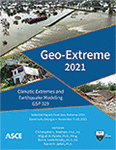Site Response and Geohazard Analysis in New York City Area
Publication: Geo-Extreme 2021
ABSTRACT
The 2014 New York City Building Code (NYCBC) requires an evaluation of liquefaction for soil at depths shallower than 15 m if standard penetration test (SPT) N60 values plot in the “liquefaction evaluation required” domain. Typically, the liquefaction assessment is performed using the maximum considered geometric mean peak ground acceleration adjusted for site class effect, which is based on SPT N60 values. A project site in New York City area was assigned Seismic Site Class F based on subsurface conditions (i.e., SPT N60 values) encountered in the borings and liquefaction analysis showing extensive potentially liquefiable layers from 2.7 to 15.5 m below ground surface on site. Therefore, in accordance with the NYCBC, a site-specific response analysis is required to determine seismic parameters for the site. To develop design seismic soil profiles, Seismic Cone Penetration Tests (SCPT) were performed to collect shear-wave velocity (VS) data. The average VS profile based on SCPT indicated a classification of Seismic Site Class D. In addition to the improvement of the Site Class, a site-specific ground motion analysis was conducted to develop a design acceleration response spectrum in accordance with the applicable provisions of ASCE 7-10 and NYCBC, using dynamic soil properties. Based on the results of the site-specific analysis, the liquefaction hazard was reevaluated. Liquefaction risk and liquefaction-induced settlements were reduced significantly utilizing site-specific analysis results. The case study demonstrates using a site-specific ground-motion analysis to obtain a refined estimate of potential earthquake-induced shaking at a site, which reduced dynamic loads, and thus reduced design and construction costs significantly.
Get full access to this article
View all available purchase options and get full access to this chapter.
REFERENCES
ASCE. (2010). Minimum Design Loads for Buildings and Other Structures, Standard ASCE/SEI 7-10. ASCE, Reston, VA.
Darendeli, M. B. (2001). Development of a New Family of Normalized Modulus Reduction and Material Damping Curves. Ph.D. Dissertation. The University of Texas at Austin, August 2001.
EPRI (Electric Power Research Institute). (1993). Guidelines for Site Specific Ground Motions. Palo Alto, CA, EPRI, November,.
Horvath, J. S., and Trochalides, T. (2004). “A Half Century of Tapered-Pile Usage at the John F. Kennedy International Airport.” Proc., Fifth Int. Conf. on Case Histories in Geotechnical Engineering, New York, NY, Paper No. 11.05.
ICC (International Code Council). (2014). 2014 New York City Building Code, First printing. ICC, Country Club Hills, IL. Technical Affairs & Code Development Division, New York City Department of Buildings, New York, NY.
Idriss, I. M., and Boulanger, R. W. (2008). Soil Liquefaction during Earthquakes,. Earthquake Engineering Research Institute, Oakland, CA.
Nikolaou, S., and Edinger, P. (2001). “Seismic Amplification of Typical New York City Soil Profiles.” Fourth International Conference on Recent Advances in Geotechnical Earthquake Engineering and Soil Dynamics, San Diego, CA, Paper No. 4.26.
Nikolaou, S. (2004). “Local geology of New York City and its effect on seismic ground motions.” Proceedings: Fifth international conference on case histories in geotechnical engineering, New York, 13-17 April 2004.
NYCDOT (New York City Department of Transportation). (2016). Seismic Design Guidelines for Bridges in Downstate Region. NYCDOT, New York, NY.
Ordonez, G. A. (2012). SHAKE2000 – A Computer Program for the 1-D Analysis of Geotechnical Earthquake Engineering Problems. GeoMotions, LLC: Lacey, Washington.
Seed, H. B. and Idriss, I. M. (1971). “Simplified procedure for evaluating soil liquefaction potential,” Journal of the Soil Mechanics and Foundation Div., ASCE, 97 (9), pp. 1249–1273.
Seed, H. B., Wong, R. T., Idriss, I. M., and Tokimatsu, K. (1986). “Moduli and Damping Factors for Dynamic Analyses of Cohesionless Soils.” Journal of Geotechnical Engineering, ASCE, 112 (11), pp. 1016–1032.
Tamaro, G. J., Kaufman, J. L., and Azmi, A. A. (2000). “Design and Construction Constraints Imposed by Unique Geologic Conditions in New York City.” Deep Foundation Institute Twenty-Fifth Annual Meeting and Eighth International Conference and Exposition, New York, NY, 3–20.
Wair, B. R., DeJong, J. T., and Shantz, T. (2012). “Guidelines for Estimation of Shear Wave Velocity Profiles.”, Pacific Earthquake Engineering Research Center Headquarters at the University of California.
Yoshimine, M., Nishizaki, H., Amano, K., and Hosono, Y. (2006). “Flow deformation of liquefied sand under constant shear load and its application to analysis of flow slide in infinite slope,” Soil Dynamics an Earthquake Eng., 26, pp. 253–264.
Youd, T. L., Idriss, I. M., Andrus, R. D., Arango, I., Castro, G., Christian, J. T., Dobry, R., Liam Finn, W. D., Harder, L. F., Jr., Hynes, M. E., Ishihara, K., Koester, J. P., Laio, S. S. C., Marcuson, W. F., III, Martin, G. R., Mitchell, J. K., Moriwaki, Y., Power, M. S., Robertson, P. K., Seed, R. B., and Stokoe, K. H., II. (2001). “Liquefaction resistance of soils: summary report from the 1996 NCEER and 1998 NCEER/NSF workshops on evaluation of liquefaction resistance of soils,” Journal of Geotechnical and Geoenvironmental Engineering, ASCE, 127 (10), pp. 817–833.
Information & Authors
Information
Published In
Copyright
© 2021 American Society of Civil Engineers.
History
Published online: Nov 4, 2021
Authors
Metrics & Citations
Metrics
Citations
Download citation
If you have the appropriate software installed, you can download article citation data to the citation manager of your choice. Simply select your manager software from the list below and click Download.
